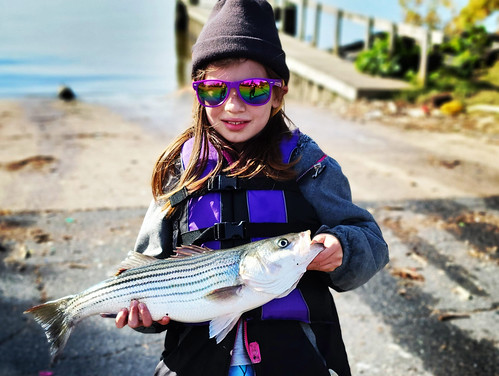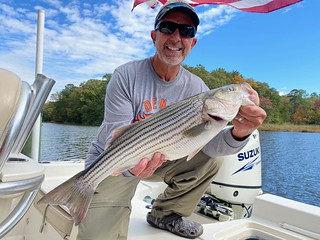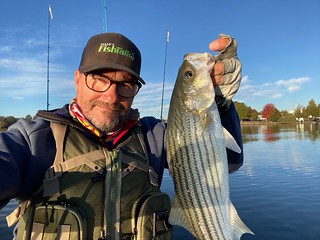Maryland Fishing Report – November 10

Lucy Perez went fishing with her dad and holds up her prize, one keeper-sized striped bass. Photo by Nick Perez
Many of Maryland’s fishing opportunities are at their zenith as cool water temperatures have fish feeling the urge to build up body stores for the coming winter months. This is good news for anglers.
Forecast Summary: November 10 – November 16:
Expect sunny, cool days and nights with rain on Friday and windy conditions on Thursday and Friday. Currently, surface waters and Bay rivers are cooling faster than the bottom waters. Bay surface water temperatures have dropped to the upper 50s. Baitfish continue to move out of the rivers and search of the deeper, warmer waters with gamefish close behind. While there will be some breaking fish action, focus on the warmer, deeper bottom waters such as river mouths, channel edges, underwater points, hard bottom, and drop-offs from the Bay Bridge south to the Virginia state line.
There is suitable oxygen to the bottom in all of Maryland’s Bay waters. Upper Bay waters down to Tilghman Island are running fresher than normal.
Expect normal flows for most Maryland rivers and streams except the Potomac and Susquehanna rivers. There will be above average tidal currents on Monday and Tuesday due to the upcoming full moon on November 19.
Expect poor water clarity caused by recent rains from the Sassafras River to Tolchester. Expect poor water clarity for the North East, Bush, Back, and upper Patapsco rivers due to algal blooms. Expect good water clarity for other Maryland rivers and main Bay areas. To see the latest water clarity conditions, check Eyes on the Bay Satellite Maps.
For more detailed and up-to-date fishing conditions in your area of the Bay, check the Maryland DNR website for Click Before You Cast. Get regular updates on Maryland’s waters sent to your inbox with our Eyes on the Bay newsletter. Sign up online.
Water clarity remains an issue in the northernmost part of the Bay but conditions are slowly improving. Conowingo Dam is on a midday power generation schedule and releases have moderated. There is some early morning striped bass action at the dam pool for those casting topwater lures, jerkbaits, and paddletails. The same action can be found along the edges of the Susquehanna Flats, but to a lesser degree due to water clarity issues. The mouths of the Elk and North East rivers also offer striped bass action in the morning and evening along shoreline structure.
Anglers fishing with live spot or eels or white perch around the mouth of the Susquehanna, Pooles Island, or areas south will find themselves dealing with hungry catfish. Some catfish being caught can weigh 30 pounds or more. If you wish for some catfish action, any fresh cut bait, nightcrawlers, clam snouts, or chicken livers will fit the bill for bait.
Jigging for striped bass along channel edges and where suspended fish can be found with depth finders is a popular way to fish in the fall. The Love Point rocks are a great location to either drift or anchor up, then cast soft plastic jigs across current and walk them along the bottom. Generally anglers are finding a good grade of striped bass at Love Point; the mouths of the Patapsco, Chester and Magothy rivers; and various knolls and shoals out in the Bay.
Trolling is another popular option, and umbrella rigs pulled behind heavy inline weights with Drone spoons or bucktails dressed with a curly tail as trailers are the way to go. Single Drone spoons and bucktails can also be trolled behind planers. The steep edges of the various shipping channels is the target. The Brewerton Channel, the Triple Buoys area, the mouth of the Chester River, Swan Point, and the main shipping channel edges are where most striped bass are holding.
White perch have been hard to find, but they do show up on some of the more popular knolls in the upper Bay and reefs at the mouths of the Magothy and Chester rivers. They are also beginning to school up deep near the Bay Bridge rock piles. Heavy but small jigs with a dropper fly are required in the swift currents at the rock piles. Calmer areas can be fished with bottom rigs baited with pieces of bloodworm.

Herb Floyd holds up a nice striped bass caught while casting in the lower Choptank. Photo by Herb Floyd
The middle Bay is alive with striped bass from the Bay Bridge south to below the Choptank River. At the Bay Bridge, jigging with skirted plastic jigs is a very effective way to fish for the better grade of striped bass that are holding tight to the concrete piers. Drifting with live spot or eels, small white perch, or cut bait is also a very productive way to catch striped bass at the bridge piers, rock piles, and sewer pipe.
The Buoy 83 channel edge has been an excellent place to find striped bass for the past week. Many anglers are jigging over the suspended fish while others are trolling umbrellas and single Drone spoons or tandem-rigged bucktails, with good results. A fair percentage of the fish are undersized but a lot of larger striped bass are being caught. Most of the shipping channel edges can hold striped bass at any time so it pays to slowly motor along them, keeping careful watch on a depth finder.
The False Channel area at the mouth of the Choptank and the Sharps Island Light are also good places to find striped bass, either holding close to the bottom or up on top chasing schools of juvenile menhaden. Jigging is a light-tackle favorite and this month is one of the best times of year to enjoy it. The striped bass have filled out for the past month; they are heavy shouldered and beautifully colored. Generally the striped bass that are on top chasing bait tend to be under 19 inches, but larger fish can be found deeper.
Trolling is a popular way to fish and requires heavy tackle to handle the umbrella rigs and inline weights. It is also a comfortable way to fish, having a warm cabin when the water is rough or the weather is rainy and cold.
Shallow water fishing in the Miles River and the Choptank remains very good for those who like to fish close to port with light tackle. Mornings and evenings offer the best times to fish. Casting a variety of topwater lures, paddletails, jerkbaits, and crankbaits are all good choices for lures when fishing along shoreline structure.
White perch are being found holding on various oyster reefs in the lower parts of the Choptank River and also in Eastern Bay. The oyster reefs out in front of Horn Point are especially good for finding white perch schooled up. Bottom rigs baited with pieces of bloodworm are popular as are dropper fly rigs.

Eric Packard holds up an early morning striped bass caught while casting from a kayak. Photo by Eric Packard
Striped bass can be found spread throughout the lower Bay from the lower Potomac River to Tangier Sound. Trolling is very popular along the steep channel edge from Piney Point to St. Georges Island, along the edges of the shipping channel in the Bay, and the channel edges near the mouth of the Patuxent River. Umbrella rigs pulled behind heavy inline weights are necessary to get down deep, where the striped bass are suspended close to the bottom. Planers will work also when pulling single Drone spoons, bucktails, or swimshads.
Jigging is popular for those who enjoy light tackle. Breaking fish can be found throughout the lower Bay. The fish on top tend to be bluefish and small striped bass but larger striped bass can often be found holding deeper. A variety of soft plastic and metal jigs work well. The mouth of the Nanticoke River and Tangier Sound are also providing good jigging action. Jigging along the bottom where the current is swift at the Hoopers Island cuts is also an excellent option.
Casting a variety of lures along shoreline structure offers great fishing in the tidal rivers of the western Bay and the marsh edges of the Eastern Shore right now. Striped bass are the main target on the tidal rivers of the western shore, and a mix of speckled trout and striped bass on the eastern side of the Bay. Pearl, silver sparkle, pink, and white paddletails tend to be the best choices to cast for speckled trout, often under a popping cork.
White perch and the last of the spot can be found on oyster bottom at the mouth of the Nanticoke and in the lower Potomac and Patuxent rivers. Most anglers are fishing with bottom rigs baited with pieces of bloodworm. There are plenty of channel and blue catfish to be caught on fresh cut bait in the lower Potomac and Patuxent rivers.

Paul Musser Sr. caught this beautiful 22-inch rainbow trout recently while fishing on the North Branch of the Potomac River. Photo courtesy of Paul Musser Sr.
Trout anglers continue to enjoy the rewards of the trout stocking that took place in October. There are plenty of trout out there, especially in the many small ponds that were stocked at the end of October. A list of these areas can be found on the DNR website.
Trout fishing is exciting in the many different management areas that are designated for delayed harvest, fly fishing, or catch and release. The water temperatures are cool and trout are feeding aggressively. The leaves are falling and can be a bit of a nuisance at times, but the colors of the beeches, oaks, and maples are gorgeous right now.
The upper Potomac is running low and clear with water temperatures in the 40s. The smallmouth bass and walleye tend to be holding in the deeper holes in the river, submerged ledges, and current breaks. A variety of soft craws, grubs, tubes, and small crankbaits are good choices for lures. Anglers should be aware that a mandatory life jacket rule on the upper Potomac goes into effect November 15.
Fishing for largemouth bass continues to be good this week. Cooler water temperatures and declining grass in the shallower areas have the largemouth bass holding an ambush line in the transition areas from the shallows to the deeper areas. They are looking for crayfish and baitfish that are moving towards structure in deeper water. Soft plastic craw jigs, small crankbaits, grubs, jerkbaits, and spinnerbaits are all good choices for lures.
Crappie are schooled up near structure in deeper waters — marina docks, bridge piers, sunken brush, sunken wood, and fallen tree tops are all excellent places to look for crappie. Casting small minnows or small jigs under a slip bobber are good ways to fish for them.
Surf anglers are catching the last of the kingfish that are still holding in the surf of Assateague Island. There are bluefish being caught on finger mullet rigs or cut mullet and striped bass on cut menhaden baits.
A look ahead for coastal fishing: right now there is some extraordinary striped bass fishing going on in northern New Jersey, with fish up to 40 pounds or more being caught as they work on schools of menhaden. As the menhaden move south, hopefully some of those large striped bass will move through Maryland waters.
At the inlet, tautog are being caught on sand fleas near the jetties, the fishing pier, and the Route 50 Bridge. Flounder are moving through the inlet and can be caught by casting Gulp baits worked along the bottom or traditional bottom rigs baited with squid and minnows. Striped bass are being caught near the Route 50 Bridge piers and the South Jetty on bucktails and soft plastic jigs.
The bay has been a bit stirred up lately but is clearing up for the weekend. Flounder are moving from the coastal bays and heading for the inlet, so any of the channels leading towards the inlet are the best areas to fish.
Outside the inlet there is good flounder fishing on the inshore shoal areas and farther offshore at the wreck and reef sites. Fishing for black sea bass at the wreck and reef sites remains very good this week with limit catches being common and a nice mix of triggerfish and flounder to round things out.
“Patience and Anticipation, two of the hallmarks of an angler; both are learned traits that have no better teacher than a fish that is out there somewhere, waiting for a lucky angler.” — Keith Lockwood
Maryland Fishing Report is written and compiled by Keith Lockwood, fisheries biologist with the Maryland Department of Natural Resources.
Click Before You Cast is written by Tidewater Ecosystem Assessment Director Tom Parham.
This report is now available on your Amazon Echo device — just ask Alexa to “open Maryland Fishing Report.”



 1-888-373-7888
1-888-373-7888 233733
233733